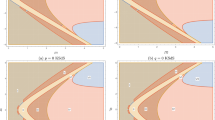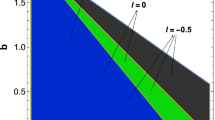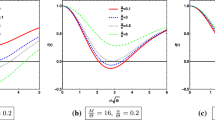Abstract
The analytic solution of a static spherical symmetrical Proca black hole is discussed in this paper. As in the massive vector field, Proca black hole can be considered as the analogy of RN background plus a perturbation with the same order as μ 2 due to the mass of vector particle μ satisfying μ 2 ≪ 1. Through the action of Proca field, we find the analytic form with the first and arbitrary order approximation. Furthermore, we divide the results into 3 groups according to the real zero solutions of the background (i.e., spacetime in massless vector field). Finally we analyze the Hawking radiation of such black hole, which is significant for constructing black hole thermodynamic.
Similar content being viewed by others
Avoid common mistakes on your manuscript.
1 Introduction
As a mysterious object, black hole was predicted from general relativity at the beginning of twenty century. So far there is still little information of black holes observed directly. A large number of theoretical physicists tried to find the clues of black hole’s existence, however there is no significant outcome until in 1974 Hawking proved that thermal radiation (Hawking radiation) can be emitted from the quantum effect near the horizon of black holes [1, 2]. Furthermore Hawking radiation can be researched by the quantum tunneling theory [3–6] and determined universally by the horizon properties, so there would be several derivations and all of them take the quantum effect in black hole backgrounds into account in various ways. Especially in 2000, Parikh and Wilczek proposed an approach to calculate the emission rate at which particles tunnel across the event horizon. They treat Hawking radiation as a tunneling process, and the WKB method is used [7, 8]. In this way a corrected spectrum, which is accurate to a first approximation, is given. Their results are considered to be in agreement with an underlying unitary theory. Following this method, a lot of static, stationary rotating and charged rotating black holes are studied [9]. In this paper, we focus on the static black hole in Proca field (i.e., massive vector field).
In the calculation of tunnelling process, the Hamilton −Jacobi method was put forward [10–19]. Originally the method was applied to Klein −Gordon equation in curved spacetime, which could be rewritten as a Hamilton −Jacobi equation via a semiclassical WKB approximation, and then the tunneling rate of the black holes can be determined. Afterwards the method was improved to be valid in fermion tunneling investigation [20]. People have used this method to study quantum tunneling from several static, stationary and non-stationary black holes, and the method is proved to be effective.
This paper is arranged as follows: we firstly discuss the analytic solution of static black hole in Proca field in Section 2; Then we calculate Hawking temperature and tunneling rate of the static Proca black hole in Sections 3. As the final part, Section 4 ends up with some discussion and prospect.
2 Analytic Solution of Static Black Hole in Proca Field
As one type of the globally neutral non-Abelian black holes, the Proca black hole model may be useful as an effective theory of massive spin 1 field. Furthermore, it may also be a simple and good model to understand common properties of black holes in Type II black holes (i.e., black holes with “massive” non-Abelian field) [21]. The stability of non-Abelian black holes against the radial perturbations have been discussed systematically by [22–31]. Each study implied that although with a simple ansatz (spherical symmetry) those non-Abelian black holes have complicated structures and show a variety of properties. In order to learn more details of such black holes, it is necessary to analyze the solutions with non-Abelian fields. Using the action, we can solve the differential equations from principle of least action. It is much difficult to deduce common analytic solutions. So we focus on the static spherical symmetrical black hole with Proca field, and calculate the analytic gauge by perturbation theory.
The static spherical symmetrical black hole has general metric as
As we known, for the classic static black hole N(r) = 1. However when the static black hole in massive vector field (i.e., Proca field), the black hole solution would be complicated. So we plan to discuss such solution firstly.
The action of Proca field in curve spacetime can be given by [21]
where F αβ = ∂ α A β −∂ β A α is electromagnetic tensor, and μ is the mass of Proca particle.
Supposing the four-potential A ν = {A 0(r),0,0,0} and substituting (1) and (2), we can find the following differential equations
Due to the mass of Proca particle is small, we consider to expand A 0(r), f(r), N(r) respectively as
where ¯ denotes the background functions with μ = 0 and ˜represents the first order perturbation terms, where δ ∼ μ 2 ≪ 1. For massless case, above differential equations give
Then substitute (6), (7) into (3)–(5) and expand the equations keeping the first-order of δ, yielding
According to the real solutions of \(\bar {f}=1+\frac {Q^{2}}{r^{2}}-\frac {2M}{r}+\frac {r^{2}\Lambda }{3}=0\), we should solve (8)–(10) in three cases (Note: here we can get Ñ (r) from (8) firstly, and then obtain à 0 (r) from (9), finally solve (10) to find f͂ (r). Since the expression of Ñ (r), à 0 (r) are so long that we list them in Appendix):
Case 1
\(1+\frac {Q^{2}}{r^{2}}-\frac {2M}{r}+\frac {r^{2}\Lambda }{3}=\frac {\Lambda }{3r^{2}}(r-r_{1})(r-r_{2})(r-r_{3})(r-r_{4})\), where r 1,r 2,r 3,r 4 are the real solutions of f̄ = 0, with the relation as r 1 + r 2 + r 3 + r 4 = 0,r 1 r 2 r 3 r 4 = 3Q 2/Λ.
Case 2
\(1+\frac {Q^{2}}{r^{2}}-\frac {2M}{r}+\frac {r^{2}\Lambda }{3}=\frac {\Lambda }{3r^{2}}(r-r_{1})(r-r_{2})(r^{2}+ar+b)\), where r 1,r 2 are the real solutions of f̄ = 0 and a, b are real constants, having the relationship as r 1 + r 2 = a, r 1 r 2 = 3Q 2/(Λb) and ab 2Λ−6bM = 3aQ 2, giving
Case 3
\(1+\frac {Q^{2}}{r^{2}}-\frac {2M}{r}+\frac {r^{2}\Lambda }{3}=\frac {\Lambda }{3r^{2}}(r^{2}+ar+b)(r^{2}+cr+d)\), where a, b, c, d are real constants, satisfying ad + bc = −6M/Λ,bd = 3Q 2/Λ,a = −c . In this case there is no real solution for f̄ = 0.
From the results, we can find all the f͂ ∼ Q 2 μ 2/Λ. As we known the mass of Proca particle is very small, so that the perturbations are bound to be much slight. Meanwhile the à 0 ∼ Q 3 μ 2/Λ2, which implies the four-potential perturbation with three power of charge leads to the gauge perturbation with twice power of charge. On the other hand, the cosmological constant Λ also play an important role on the Proce field perturbation.
In order to improve the accuracy of this method, we also can calculate the A 0(r), f(r), N(r) with higher order of μ 2. The (3)–(5) yield
We do the transform as μ 2=δ, where δ ≪ 1, and then expand N 2(r), A(r) and f(r) as
where the \(N^{2}_{(i)}\), A 0(i) and f (i) represent the coefficient of δ i. If we want to evaluate the analytic solution to n order approximation, it is just to deduce the coefficients of δ 0 to δ n−1, then
Therefore
where C N (r), C A 0(r) and C f (r) are determined by \(A_{0(0)}...A_{0(n-1)},N^{2}_{(0)}...N^{2}_{(n-1)}\) and f (0)...f (n−1). Therefore, the arbitrary order solution can be obtained in principle.
3 Hawking Temperature and Tunneling Rate of the Static Proca Black Hole
Next the properties of black holes can be revealed by Hawking radiation [32–34]. we employ Hamilton-Jacobi equation, which can be used to uniformly calculate all kinds of tunneling radiation from black hole [35], to study the Hawking temperature and tunneling rate of Proca black hole. The charged Hamilton −Jacobi equation is given by [36]
Separating the variable for the action S as
The electro-magnetic potential is
In the spacetime (1) we can rewrite the (22) as
Then (25) can be factorized into angular and radial equations
and
Just Hawking radiation only depend on radial equation, so solving the radial equation (27) we can deduce R(r) as
Considering the Hawking radiation happen at horizon r = r 0, the above equation can be simplified by residue theorem as
we can give the tunneling rate as
and Hawking temperature is
The first term of (31) indicates the temperature of the black hole in massless vector field and the second term implies the effect of Proca particle’ mass on the black hole’s temperature. According to (6), (11)–(13) and appendix, the horizon r 0 would be found by solving \(f(r_{0}) = \bar {f}(r_{0})+\delta \tilde {f}(r_{0})+\mathcal {O}(\delta ^{2}) = 0\). So in principle, the tunneling rate and Hawking temperature can be calculated following above equations. But due to the complicated expressions, we do not further list the detailed equations of Γ and T h .
4 Conclusion
Although in traditional theory the vector field should be massless, nowadays some theories (as Higgs mechanism) and experiments (e.g. Test of U(1) local gauge invariance in Proca electrodynamics [37]) present the possibility of massive particle with 1 spin. As a more accurate result, the analytic black hole solution in this paper reflect how the mass of photon impacts on static spacetime. In the three cases mentioned above, we can find that the effect of photon mass is very weak but would not be neglected. When the mass μ = 0 the spacetime returns to RN analogue, furthermore when Q = 0 it should be reduced to Schwarzschild black hole.
Meanwhile we discussed the Hawking radiation of such black hole, which implies the horizon r 0 plays important role in the tunnelling rate and black hole’s temperature. In the next step, we plan to analyze the quasinormal modes (QNMs) of such black hole. Since the QNMs can give a glimpse into the interior region of black holes, the more information about black hole’s evolution would be revealed. Furthermore the work of QNMs make us step closer to quantum gravity.
References
Hawking, S.W.: Nature 248, 30 (1974)
Hawking, S.W.: Commun. Math. Phys. 43, 199 (1975)
Kraus, P., Wilczek, F.: Nucl. Phys. B 433, 403 (1995). arXiv:9408003 [gr-qc]
Robinson, S.P., Wilczek, F.: Phys. Rev. Lett. 95, 011303 (2005). arXiv:0502074 [gr-qc]
Iso, S., Umetsu, H., Wilczek, F.: Phys. Rev. D 74, 044017 (2006). arXiv:0606018 [hep-th]
Parikh, M.K., Wilczek, F.: Phys. Rev. Lett. 85, 5042 (2000). arXiv:9907001 [hep-th]
Parikh, M.K.: Int. J. Mod. Phys. D 13, 2355 (2004). arXiv:0405160 [hep-th]
Parikh, M.K.: The Tenth Marcel Grossmann Meeting. In: Proceedings of the MG10 Meeting held at Brazilian Center for Research in Physics (CBPF) (2006). arXiv:http://www.worldscientific.com/worldscibooks/10.1142/6033 [hep-th]
Zhang, J.Y., Zhao, Z.: Phys. Lett. B 638, 110 (2006). arXiv:0512153 [gr-qc]
Srinivasan, K., Padmanabhan, T.: Phys. Rev. D 60, 24007 (1999)
Akhmedov, E.T., Akhmedova, V., Singleton, D.: Phys. Lett. B 642, 124 (2006)
Angheben, M., Nadalini, M., Vanzo, L., Zerbini, S.: J. High Energy Phys. 0505, 014 (2005)
Shankaranarayanan, S., Padmanabhan, T., Srinivasan, K.: Class. Quant. Grav. 19, 2671 (2002)
Cai, R.G., Cao, L.M., Hu, Y.P.: J. High Energy Phys. 0808, 090 (2008)
Banerijee, R., Majhi, B.R.: J. High. Energy Phys. 0806, 095 (2008)
Majhi, B.R.: Phys. Rev. D 79, 044005 (2009)
Modak, S.K.: Phys. Lett. B 671, 167 (2009)
Lin, K., Yang, S.Z.: Europhys. Lett. 82, 20006 (2009)
Lin, K., Yang, S.Z.: Int. J. Theor. Phys. 48, 2920 (2009)
Lin, K., Yang, S.Z.: Chin. Phys. B 20, 110403 (2011)
Torii, T., Maeda, K.-I., Tachizawa, T.: Phys. Rev. D 51, 1510 (1995). arXiv:9406013 [gr-qc]
Torii, T., Maeda, K.: Phys. Rev. D 48, 1643 (1993)
Galtsov, D.V., Volkov, M.S.: Phys. Lett. A 162, 144 (1992)
Straumann, N., Zhou, Z.-H.: Phys. Lett. B 234, 33 (1990)
Zhou, Z.-H., Straumann, N.: Nucl. Phys. B 234, 180 (1991)
Bizon, P.: Phys. Lett. B 259, 53 (1991)
Bizon, P., Wald, R.M.: Phys. Lett. B 259, 173 (1991)
Heusler, M., Droz, S., Straumann, N.: Phys. Lett. B 271, 61 (1991)
Bizon, P. Acta Phys. Polon B 25, 877 (1994). arXiv:9402016 [gr-qc]
Gibbons, G.W., Maeda, K.: Nucl. Phys. B 298, 741 (1988)
Garfinkle, D., Horowitz, G.T., Strominger, A.: Phys. Rev. D 43, 3140 (1991)
Hawking, S.W.: Nature 248, 30 (1974)
Hawking, S.W.: Commun. Math. Phys. 43, 199 (1975)
Damoar, T., Ruffini, R.: Phys. Rev. D 14, 332 (1976)
Yang, S.Z., Lin, K., Li, J.: Hawking radiation of black hole in Einstein-Proca theory. Int. J. Theor. Phys. (2014) doi:10.1007/s10773-013-1968-6
Lin, K., Yang, S.Z.: Chin. Phys. B 20, 110403 (2011)
Tu, L.C., Shao, C.C., Luo, J.: Phys. Lett. A 352, 267 (2006)
Acknowledgments
This work was supported by National Natural Science Foundation of China No. 11205254, No. 11178018 and No. 11075224, and the Natural Science Foundation Project of CQ CSTC 2011BB0052, and the Fundamental Research Funds for the Central Universities CQDXWL-2013-010,CDJZR12160015 and CDJRC10300003.
Author information
Authors and Affiliations
Corresponding author
Appendix
Appendix
In the appendix, for the case 1, case 2, case 3 mentioned in Section 2, we list the perturbation functions Ñ (r) and à 0 (r) with corresponding subscripts respectively. Here we only retain the coefficients of δ.
Case 1
\(1+\frac {Q^{2}}{r^{2}}-\frac {2M}{r}+\frac {r^{2}\Lambda }{3}=\frac {\Lambda }{3r^{2}}(r-r_{1})(r-r_{2})(r-r_{3})(r-r_{4})\):
Case 2
\(1+\frac {Q^{2}}{r^{2}}-\frac {2M}{r}+\frac {r^{2}\Lambda }{3}=\frac {\Lambda }{3r^{2}}(r-r_{1})(r-r_{2})(r^{2}+ar+b)\):
Case 3
\(1+\frac {Q^{2}}{r^{2}}-\frac {2M}{r}+\frac {r^{2}\Lambda }{3}=\frac {\Lambda }{3r^{2}}(r^{2}+ar+b)(r^{2}+cr+d)\):
Rights and permissions
About this article
Cite this article
Zhong, Y., Li, J. & Lin, K. An Analytic Approximation for Researching Tunneling Rate from Black Hole in Proca Field. Int J Theor Phys 53, 3035–3045 (2014). https://doi.org/10.1007/s10773-014-2099-4
Received:
Accepted:
Published:
Issue Date:
DOI: https://doi.org/10.1007/s10773-014-2099-4




